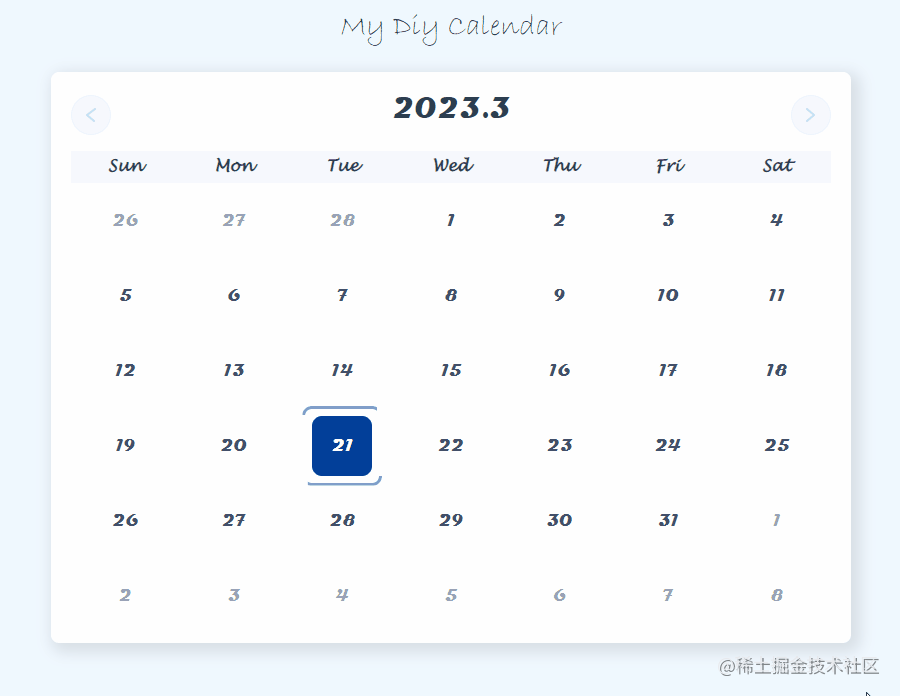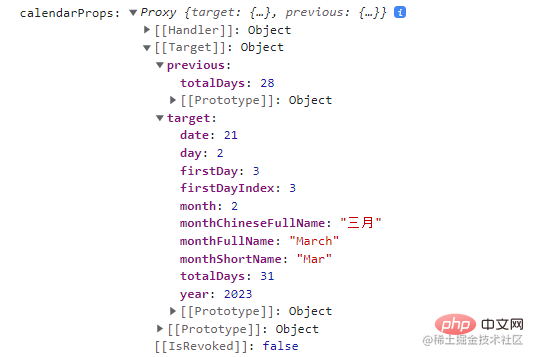深析如何封裝一個vue自訂日曆元件
- 藏色散人轉載
- 2023-04-06 15:12:402344瀏覽
這篇文章為大家帶來了關於前端日曆的相關知識,其中主要跟大家聊一聊如何封裝一個自定義日曆組件,感興趣的朋友下面一起來看一下吧,希望對大家有幫助。
前言
眾所周知啊,一般來說,如果專案中有需要用到行事曆元件,往往是找第三方UI函式庫中的元件來使用,或是找現成的其他第三方插件。對很多朋友來說,第一眼看到日曆組件,下意識的就會覺得很複雜,無從下手。但是當我閱讀了這個日曆插件的源碼之後,發現並沒有我想像中的複雜。我以前傻傻得認為,想要做一個日曆組件,得需要把距離現在年份前後至少十年的日曆資料都獲取到,然後才能進行下一步的開發。
然而,在我嘗試著閱讀了dycalendar.js這個函式庫的源碼之後,一方面感覺自己太笨了,把問題想得太複雜了。另外也感慨作者思路之清晰。看完後感覺受益匪淺。
在將作者的思路邏輯梳理完畢後,我依據這個思路開發了一個vue元件。如下圖所示:

接下來,就隨著我一起看看如何開發自己的行事曆元件。
核心程式碼實作
1、梳理想法
- 取得到目標日期資料
- 取得到目前日期的各項重要屬性,諸如
目前年,目前月,目前日期,目前星期幾,目前月一共有幾天,目前月的第一天對應的是星期幾,上個月總共有多少天等。 - 根據這些屬性,來產生特定的
日曆日期資料清單,然後將其循環渲染到範本中。 - 當切換月份的時候,取得到新的目標日期對應的各項關鍵資料。 vue偵測到日曆屬性變更之後,通知頁面進行更新。
2、初始化所需的資料
一般來說,成熟的行事曆元件,日期都是一個雙向綁定的變數。為了方便使用,我們也採用雙向綁定的方式。
<script setup>
import { reactive, ref, computed, watch } from "vue";
const props = defineProps({
modelValue: Date,
});
const emits = defineEmits(["update:modelValue"]);
/**
* 最小年份
*/
const MIN_YEAR = 1900;
/**
* 最大年份
*/
const MAX_YEAR = 9999;
/**
* 目标日期
*/
const targetDate = ref(props.modelValue);接下來,我們還需要初始化一些常數用來表示月份和日期:
/**
* 有关月度的名称列表
*/
const monthNameList = {
chineseFullName: [
"一月",
"二月",
"三月",
"四月",
"五月",
"六月",
"七月",
"八月",
"九月",
"十月",
"十一月",
"十二月",
],
fullName: [
"January",
"February",
"March",
"April",
"May",
"June",
"July",
"August",
"September",
"October",
"November",
"December",
],
mmm: [
"Jan",
"Feb",
"Mar",
"Apr",
"May",
"Jun",
"Jul",
"Aug",
"Sep",
"Oct",
"Nov",
"Dec",
],
};
/**
* 有关周几的名称列表
*/
const dayNameList = [
{
chineseFullName: "周日",
chineseShortName: "日",
fullName: "Sunday",
shortName: "Sun",
dayNumber: 0,
},
{
chineseFullName: "周一",
chineseShortName: "一",
fullName: "Monday",
shortName: "Mon",
dayNumber: 1,
},
{
chineseFullName: "周二",
chineseShortName: "二",
fullName: "Tuesday",
shortName: "Tue",
dayNumber: 2,
},
{
chineseFullName: "周三",
chineseShortName: "三",
fullName: "Wednesday",
shortName: "Wed",
dayNumber: 3,
},
{
chineseFullName: "周四",
chineseShortName: "四",
fullName: "Thursday",
shortName: "Thu",
dayNumber: 4,
},
{
chineseFullName: "周五",
chineseShortName: "五",
fullName: "Friday",
shortName: "Fri",
dayNumber: 5,
},
{
chineseFullName: "周六",
chineseShortName: "六",
fullName: "Saturday",
shortName: "Sat",
dayNumber: 6,
},
];接下來,準備幾個vue的回應式資料:
/**
* 今日
*/
const today = new Date();
/**
* 日历的各项属性
*/
const calendarProps = reactive({
target: {
year: null,
month: null,
date: null,
day: null,
monthShortName: null,
monthFullName: null,
monthChineseFullName: null,
firstDay: null,
firstDayIndex: null,
totalDays: null,
},
previous: {
totalDays: null,
},
});
/**
* 用于展现的日历数据
*/
const calendarData = ref([]);3 、初始化日曆的各項屬性
接下來,透過setCalendarProps方法取得行事曆的各個屬性,逐一填入calendarProps中的資料:
function setCalendarProps() {
if (!targetDate.value) {
targetDate.value = today;
}
// 获取目标日期的年月日星期几数据
calendarProps.target.year = targetDate.value.getFullYear();
calendarProps.target.month = targetDate.value.getMonth();
calendarProps.target.date = targetDate.value.getDate();
calendarProps.target.day = targetDate.value.getDay();
if (
calendarProps.target.year < MIN_YEAR ||
calendarProps.target.year > MAX_YEAR
) {
console.error("无效的年份,请检查传入的数据是否是正常");
return;
}
// 获取到目标日期的月份【中文】名称
let dateString;
dateString = targetDate.value.toString().split(" ");
calendarProps.target.monthShortName = dateString[1];
calendarProps.target.monthFullName =
monthNameList.fullName[calendarProps.target.month];
calendarProps.target.monthChineseFullName =
monthNameList.chineseFullName[calendarProps.target.month];
// 获取目标月份的第一天是星期几,和在星期几中的索引值
const targetMonthFirstDay = new Date(
calendarProps.target.year,
calendarProps.target.month,
1
);
calendarProps.target.firstDay = targetMonthFirstDay.getDay();
calendarProps.target.firstDayIndex = dayNameList.findIndex(
(day) => day.dayNumber === calendarProps.target.firstDay
);
// 获取目标月份总共多少天
const targetMonthLastDay = new Date(
calendarProps.target.year,
calendarProps.target.month + 1,
0
);
calendarProps.target.totalDays = targetMonthLastDay.getDate();
// 获取目标月份的上个月总共多少天
const previousMonth = new Date(
calendarProps.target.year,
calendarProps.target.month,
0
);
calendarProps.previous.totalDays = previousMonth.getDate();
}要注意的一個知識點是,在取得本月多少天和上個月多少天的時候,都將date值設定為了
0。這是因為當date值為0的時候,傳回的Date物件是上個月的最後一天。所以說,為了取得本月多少天,需要將本月的month值加1。
執行這個方法之後,此時calendarProps的值為:

4、根據日曆屬性產生日曆日期的數據
當我們已經知道本月第一天對應的周幾索引值、本月一共有多少天和上個月一共有多少天這三個核心資料之後,就可以開始產生對應的日曆資料了。
想法如下:
- 由於大部分情況下,本月的第一天不是從頭開始的,之前的部分是上個月的日期。所以第一行要單獨處理。
- 設定一個公用的date數值,初始值設定為
1。然後從本月第一天對應的周幾索引值開始進行遞增。本月之前的日期和之後的日期設定一個演算法進行計算。 - 為了方便之後進行日期切換、樣式區分,將產生的資料加工成一個對象,其中包含日期類型-
dateType,表示是本月還是上月還是下個月;
/**
* 生成日历的数据
*/
function setCalendarData() {
let i;
let date = 1;
const originData = [];
const firstRow = [];
// 设置第一行数据
for (i = 0; i <= 6; i++) {
// 设置目标月份之前月份的日期数据
if (i < calendarProps.target.firstDayIndex) {
const previousDate =
calendarProps.previous.totalDays -
calendarProps.target.firstDayIndex +
(i + 1);
firstRow.push({
dateObj: new Date(
calendarProps.target.year,
calendarProps.target.month - 1,
previousDate
),
dateNumber: previousDate,
dateType: "previous"
});
} else {
// 设置目标月份当月的日期数据
firstRow.push({
dateObj: new Date(
calendarProps.target.year,
calendarProps.target.month,
date
),
dateNumber: date,
dateType: "current"
});
date++;
}
}
originData.push(firstRow);
// 设置后面五行的数据
for (let j = 0; j <= 4; j++) {
const rowData = [];
for (let k = 0; k <= 6; k++) {
// 设置目标月份剩下的日期数据
if (date <= calendarProps.target.totalDays) {
rowData.push({
dateObj: new Date(
calendarProps.target.year,
calendarProps.target.month,
date
),
dateNumber: date,
dateType: "current"
});
} else {
// 设置目标月份下个月的日期数据
const nextDate = date - calendarProps.target.totalDays;
rowData.push({
dateObj: new Date(
calendarProps.target.year,
calendarProps.target.month + 1,
nextDate
),
dateNumber: nextDate,
dateType: "next"
});
}
date++;
}
originData.push(rowData);
}
calendarData.value = originData;
}至此,這個日曆元件的核心部分的邏輯就已經實現了。你看,是不是很簡單呢?
接下來,我們只需要根據calendarData中的資料渲染出對應的html模板和新增上樣式就可以了。
5、新增範本和樣式部分
#一般來說,日曆元件都是網格狀的結構,所以我選擇table的方式來渲染。不過你要問我還有沒有別的方式,那還是有的,例如使用flex佈局或grid佈局,但是如果採用這種方式的話,calendarData的資料結構就不是現在這個樣子了。
dom結構如下圖:

至於按鈕邊框的流動效果,是我參考蘇甦的文章做的,詳情請見:
Clip-path實現按鈕流動邊框動畫juejin.cn/post/719877…
然後剩下的樣式部分,即興發揮或根據UI設計圖繪製即可。 想必各位都領教過UI姐姐們精美的設計圖吧(嘻嘻
具體的代碼部分就不貼在文章中了,如有需要可以直接查看下方的完整源碼
#結語
有些感覺很麻煩的元件,可能核心邏輯往往不是那麼複雜。有些時候,可能只是需要一些耐心,將程式碼一行一行的拆解出來閱讀,理清楚其中的思路。
推薦學習:《vue影片教學》
以上是深析如何封裝一個vue自訂日曆元件的詳細內容。更多資訊請關注PHP中文網其他相關文章!

